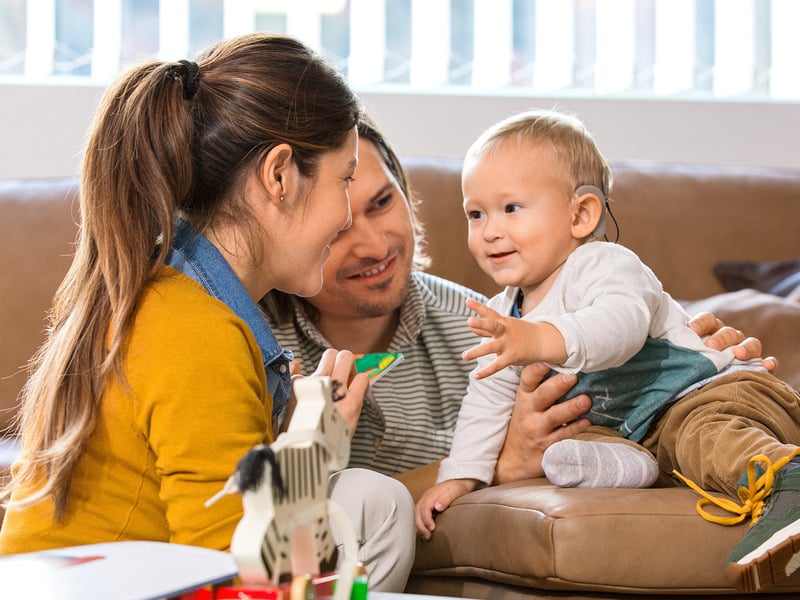
MED-EL
Published Oct 04, 2023
Is Parentese (Baby Talk) Helpful for Children With Hearing Loss?
Baby Talk, also known as “parentese,” is known to be helpful for all babies and infants (0 – 18 months), not just babies with typical hearing, in the development of communication skills. Parentese attracts and maintains infants' attention and aids in language learning.

Babies prefer listening to parentese than to other speech, such as adult-directed speech, even in a foreign language. For children using hearing implants, parentese is even more important as it is naturally more interesting to listen to, is inherently slower, emphasizes key words, and uses repetition. All of these characteristics make speech easier to listen to, learn from, and understand for children with hearing implants.
How to Use Parentese
1. Be close and face-to-face with your baby
Being close to your child’s audio processor allows you to provide the best auditory information. Your facial expressions also give your child additional clues that help them understand you when you talk. Interesting facial expressions will help keep your child engaged in communication with you.
2. Use exaggerated, varying intonation patterns
Your voice will have a sing-song melody if you use exaggerated and varying intonation patterns. This enables you to highlight the key words of the sentence. And varying intonation also makes speech more interesting to listen to.
3. Slow down your rate of speech
It is easier to listen to, understand, and learn from slower speech. Slowing down your speech will help your child with a cochlear implant understand your words.
4. Emphasize and repeat key words
By repeating key words, you draw your child’s attention to the important parts of the sentence and give your child another chance to hear and learn them. Children must hear words many times in interesting, meaningful contexts before they can understand what they mean. Only after children understand words can they use them in their own speech.
5. Add interesting sounds such as “wow,” “oooh,” or related animal or vehicle sounds
Such sounds, often referred to as Play Sounds or Learning to Listen Sounds, are interesting to listen to, easy to imitate, and easy to connect to objects and actions. Play sounds, such as “uh-oh,” are easy to imitate and are often used in fun and engaging situations in which children learn easily. Children may learn the Play Sound for an object or action—”shhh” for sleeping, for example—before they learn to use the word (“sleep”). Remember to use both the word and the Play Sound. Say, for example, “here comes the horse, neigh says the horse.”
6. Talk about what the child is looking at, playing with, or might be feeling
Focus on talking about what your child is interested in so that they connect what you are talking about with what they are thinking about or feeling. When you are both thinking about and talking about the same thing, your child is more likely to learn from your words.
7. Use pauses
Pauses allow your child time to process what you have said and respond to your communication. Pausing also teaches your child that communication goes both ways. Use pauses to encourage them to take a turn in the conversation. Their response could be through vocalizations, gestures, facial expressions, or eye movements.
Widespread research has found that parentese is just as important for babies with hearing loss as it is for children with typical hearing.1 It supports language learning as well as speech and cognitive development more than adult-directed speech. Whether your child uses hearing devices or is waiting for a cochlear implant, the use of parentese is beneficial.
References

MED-EL
Was this article helpful?
Thanks for your feedback.
Sign up for newsletter below for more.
Thanks for your feedback.
Please leave your message below.
Thanks for your message. We will reply as soon as possible.
Send us a message
Field is required
John Doe
Field is required
name@mail.com
Field is required
What do you think?
© MED-EL Medical Electronics. All rights reserved. The content on this website is for general informational purposes only and should not be taken as medical advice. Contact your doctor or hearing specialist to learn what type of hearing solution suits your specific needs. Not all products, features, or indications are approved in all countries.

MED-EL

MED-EL



Conversation
2 Comments